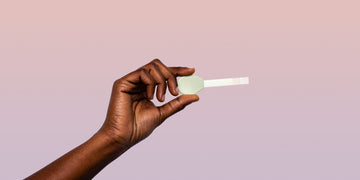How to take a UTI test: A guide to UTI testing

If you're taking a UTI test for the first time or just want a refresher, here's our complete guide to using UTI tests.
What's in your UTI test kit
Winx Health (formerly known as Stix) UTI Tests come with 3 UTI tests, 3 pH balanced wipes (so you can cleanse before you test if you want – it's optional), and 3 color comparison charts located on the test wrapper to interpret your results.
What you'll need
Before you start your UTI test, make sure you have these: something to keep time with, a paper towel or some toilet paper, and the color chart on the UTI test wrapper so you can interpret your results.
How UTI tests work
UTI tests detect a urinary tract infection (UTI) by measuring the levels of leukocytes (white blood cells) and nitrate in your urine. The higher your levels, the more likely you have a UTI.
Test, treat, and prevent UTIs
Our UTI test offers high quality results from the comfort of your home. It detects nitrite levels as low as 0.075-0.10 mg/dl and leukocyte levels as low as 15 White Blood Cells/μL. This allows us to get you more accurate results sooner.

When should you take a UTI test?
If you feel pain and burning when you pee, it’s time to test. Other UTI symptoms can include feeling like you constantly need to pee, or only passing small amounts of urine even when you really have to go.
How to take a UTI test
Step 1: Use the pH balanced wipe to cleanse your urethra (where you pee from). Always wipe front to back!
Step 2: Open the foil pouch and grab the test by the plastic thumb grip.
Step 3: Pee for a few seconds, then hold the tip of the test strip in your urine stream for 1-2 seconds. Both of the test pad squares should be damp. If it’s easier, dip the test pads in a small cup of urine for 1-2 seconds instead.
Step 4: Gently dab the test strip on a paper towel to remove excess urine and set it on a flat surface with the testing pads facing up.
Step 5: Wait 1 minute, then hold the bottom test pad (the nitrite test) up to the color chart on the wrapper and compare your result. Take a picture for reference.
Step 6: Wait 1 more minute, then hold the top test pad (the leukocyte test) up to the color chart on the foil pouch and compare your result. Take a picture for reference.
How to read UTI test results
Match your test strip to the closest color block on the test wrapper’s color chart. The color of the strip indicates whether the test is positive, negative, or if you have traces of nitrite and leukocytes. Remember that the color of the strip will be a slightly darker yellow after it absorbs your urine, which isn’t caused by a difference in pH.
If your results suggest you have a UTI
Three types of results can indicate that you have a UTI:
- Both your leukocyte and nitrite results are positive
- Your leukocyte result is positive and your nitrite result is negative
- Your leukocyte result shows trace amounts and your nitrite result is positive
Be sure to drink lots of water and talk to your doctor about next steps for treatment.
If your results indicate signs of a UTI
If your leukocyte result is negative and your nitrite result is positive, signs of a UTI are present. Take another test the next time you pee — if results stay the same or turn positive, talk to your doctor.
If your results are unclear
If your leukocyte result shows trace amounts and your nitrite result is negative, your results are inconclusive. Take another test the next day. If you get the same result, or still have symptoms, talk to your doctor about additional testing.
If your results suggest you don't have a UTI
If your leukocyte result is negative and your nitrite result is positive, no UTI was detected. If you still have symptoms, talk to your doctor about additional testing.
What can affect UTI test results
Several factors can produce inaccurate test results. Talk to your doctor about a UTI if you:
- Are dehydrated or extremely over-hydrated (too much water dilutes your urine).
- Are taking medications like antibiotics or anything that alters your urine color (such as anything containing azo dyes, nitrofurantoin, or riboflavin).
- Are experiencing urine with a ph > 8, kidney stones, severe vomiting, blood in your urine, or other major alterations to your urine.
Questions?
We’re here for you, every step of the way. Say hi at hi@hellowinx.com.
Keep Reading

Yeast infection vs. UTI: Which one do I have?
November 13 • 3 min

Can I take a UTI test at home?
Nov 17

How to treat a UTI during pregnancy
Oct 8










